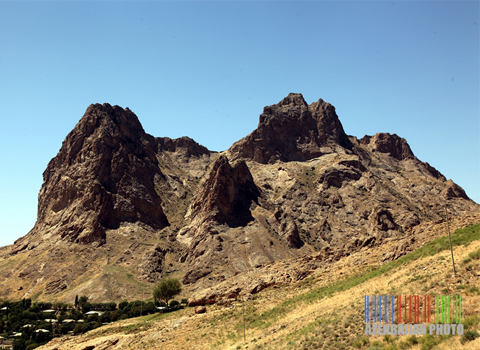Julfa: pure history and astonishing nature

By Nigar Orujova
The weather gets more autumn-ish in Azerbaijan day by day now, making it possible to visit regions that were too hot during the summer.
One such place with equator like heat in midsummer is the Julfa region of Nakhchivan, a not-very-well-known area in Azerbaijan, situated in the south-west of the Lesser Caucasus.
Not being a travel destination, Nakhchivan still have many natural and manmade wonders to show.
The Julfa region is a mountainous area which the river Aras crosses. The Ilandag Mountain has turned into the symbol of Julfa and the whole of Nakhchivan. The name of the mountain means "Snake's Mountain", because this high mountain, which can bee see from everywhere in Julfa, is full of poisonous reptiles.
Julfa was a major Silk Way stopover for many years, and ancient caravan roads from Iran to Shirvan, Georgia, and Dagestan passed through the region, enriching it with material and spiritual values.
You can visit the Gulustan village in Julfa to see Azerbaijan's oldest 13th century caravansary. You will also find a historical bridge around the village, going back to the 12th century, as well as a necropolis. The main attraction here is the13th century Gulustan fortress, which consists of a group of tower-like tombs. However, being situated on the border with Iran, it is not open to visitors.
Another interesting village with 14-17 century historical monuments is the Khanagha village. Two must-see places of Julfa are situated in this village: the Alinja fortress and the Khanaghah architectural complex.
Be careful with Alinja fortress, which located in a mountain of the same name, because it turns into a real snake nest starting from May until the start of cold weather. You can visit it early in the morning until noon. Be ready to climb for hours, though it worth trying, as the air is pure and smells of thyme.
At the top, you will find the remains of the fortress that served as a shelter for the ruling family during military uprisings. Scientists believe that it was constructed in 11-13 centuries. Many rulers tried to occupy Alinja, but it stayed unassailable, and even the famous Amir Timur could only reach it after keeping the fortress under siege for over 10 years.
After climbing the Alinja mountain, you can rest while visiting the Khanaga village, a medieval architectural complex that holds the ruins of a tomb and mosque and columns of an unknown monument. Locals believe that Fazlallah Naimi was buried there.
Naimi, who lived in 1340-1402, was founded of Hurufism sect widespread in the Near and Middle East in middle ages. He was executed by Amir Timur's son for his promotion of Hurufism and struggle against Amir Timur.
The land of Julfa is rich in valuable ore and minerals and if you visit the colorful Daridagh situated 8 km northeast of Julfa, you can see it for yourself. Minerals have changed the color of its rocks and ground, making it seem unreal.
Mineral water at the foot of Daridagh is supplied by five springs and 32 exploration wells. It gives 500,000 liters of water a day, just like the mineral waters of Poland, France, and Germany.
After this long and exhausting trip, you can visit the Daridagh sanatorium, an arsenical water sanatorium, which has the highest and most powerful mineral content in Azerbaijan and provides treatment for different cardiovascular, musculoskeletal system, peripheral nervous system, skin, gynecological, and other diseases.
There is no doubt that after visiting so many historical places and hearing captivating stories, enjoying the astonishing natural environment, and taking healthful baths, you will fall in love with Julfa.
